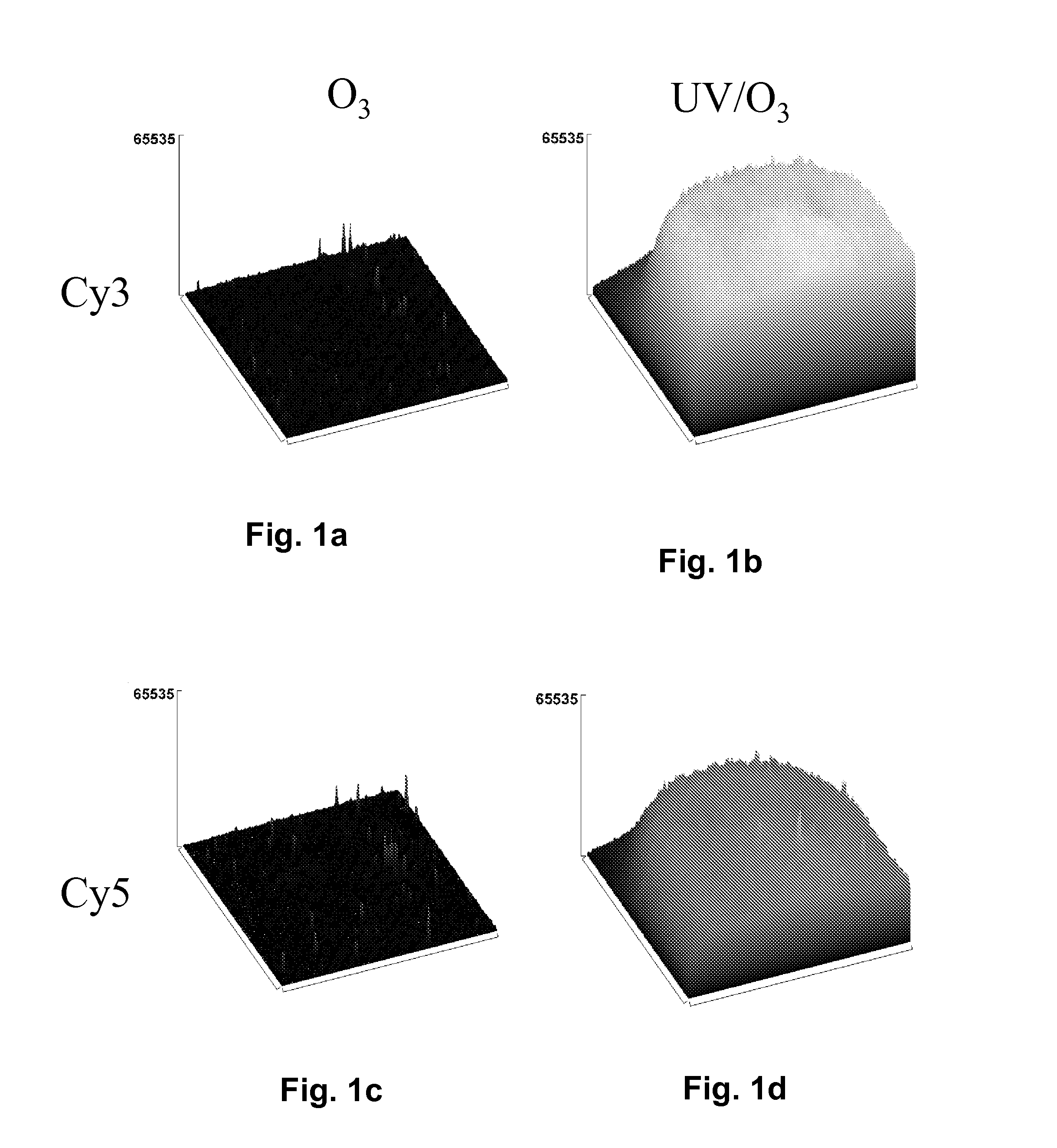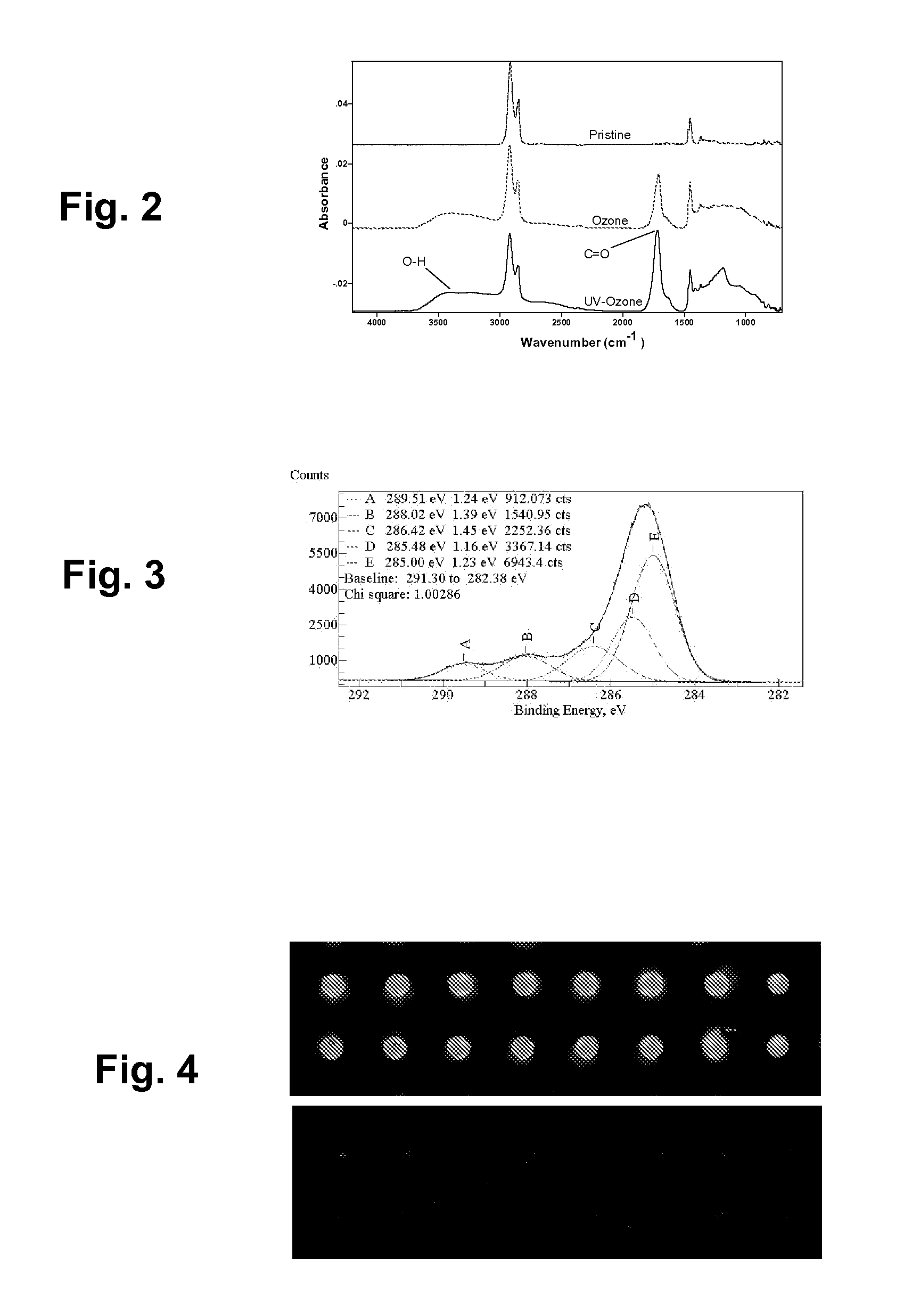Microdevice for a Fluorescence-based Assay, and a Method for Making the Microdevice
a fluorescence-based assay and micro-device technology, applied in fluorescence/phosphorescence, laboratory glassware, paper/cardboard containers, etc., can solve the problems of high cost of micro-machining of glass, and high cost of glass micro-machining
- Summary
- Abstract
- Description
- Claims
- Application Information
AI Technical Summary
Benefits of technology
Problems solved by technology
Method used
Image
Examples
example 1
Selection of Substrate
[0043]The ideal substrate needed for the fabrication of high throughput screening devices that are based on fluorescence detection should have the following properties: i) provide rapid microfabricaton and scalable production that will ensure low-cost manufacturing, ii) low intrinsic fluorescence background as well as low fluorescence due to non-specific-binding and iii) allow a simple, scalable and environmentally friendly surface chemistry for the immobilization of biomolecules.
[0044]Substrates were pre-screened solely based on their performance in micromachining, namely hot embossing, optical transmission and intrinsic fluorescence. The microfabrication requirement can be met by restricting the potential substrates to thermoplastics since embossing is a suitable technique for industrial fabrication. Further refinement of the list of potential plastics was accomplished by excluding polymers containing aromatic or conjugated systems since they are expected to ...
example 2
Comparison of Poly(cyclic olefin) Intrinsic Fluorescence Levels
[0053]FIG. 1a shows the level of intrinsic fluorescence from a sample of Zeonor 1060R after treatment with 3% ozone in the absence of UV, with excitation at 550 nm and emission at 570 nm (Cy3 wavelengths). Similarly, FIG. 1c shows the level of fluorescence from a sample of Zeonor 1060R after treatment with 3% ozone in the absence of UV for 1 hour, with excitation at 650 nm and emission at 670 nm (Cy5 wavelengths). These figures can be contrasted with FIGS. 1b and 1d which show the levels of intrinsic fluorescence when a sample of Zeonor 1060R is treated with 3% ozone while irradiating with the full spectrum of a 100 Watts mercury lamp for 1 hour, at Cy3 and Cy5 wavelengths respectively.
example 3
Surface Chemistry and Immobilization of DNA on Poly(Cyclic Olefins)
[0054]Generally poly(cyclic olefins) are obtained from the copolymerization of ethene and a cyclic olefin. For instance, Topas™ (Ticona Inc.) and APEL™ (Mitsui Chemical) are synthesized via chain copolymerization of monomers such as 8,9,10-trinorborn-2-ene (norbornene) or 1,2,3,3,4,4a,5,8,8a-octahydro-1,4:5,8-dimethanonaphthalene (tetracyclo dodecene) with ethene yielding a saturated hydrocarbon. On the other hand, Zeonex and Zeonor resins are produced by ring-opening metathesis polymerization of a number of cyclic olefinic monomers, followed by a hydrogenation step. The hydrogenation step is necessary for increasing the thermal stability of the plastic by removing carbon-carbon double bonds that are necessarily formed during the polymerization process (T. Nielsen, D. Nilsson, F. Bundgaard, P. Shi, P. Szabo, O. Geschke, A. Kristensen, J. Vac. Sci. Technol. B 2004, 22, 4, 1770-1775; J. Y. Shin, J. Y. Park, C. Liu, J. ...
PUM
| Property | Measurement | Unit |
|---|---|---|
| Percent by mass | aaaaa | aaaaa |
| Time | aaaaa | aaaaa |
| Concentration | aaaaa | aaaaa |
Abstract
Description
Claims
Application Information
 Login to View More
Login to View More - R&D
- Intellectual Property
- Life Sciences
- Materials
- Tech Scout
- Unparalleled Data Quality
- Higher Quality Content
- 60% Fewer Hallucinations
Browse by: Latest US Patents, China's latest patents, Technical Efficacy Thesaurus, Application Domain, Technology Topic, Popular Technical Reports.
© 2025 PatSnap. All rights reserved.Legal|Privacy policy|Modern Slavery Act Transparency Statement|Sitemap|About US| Contact US: help@patsnap.com



